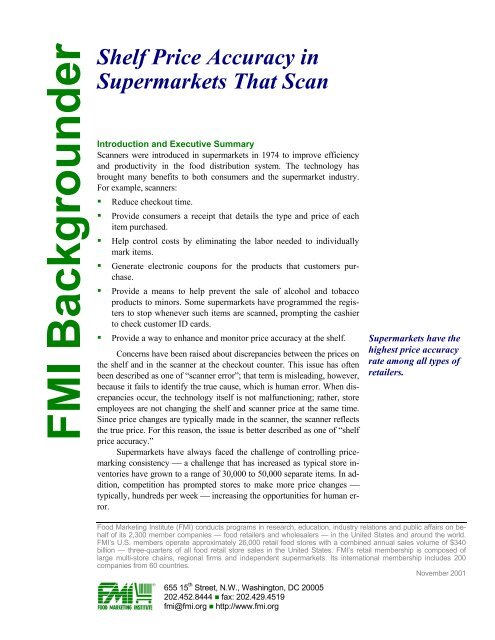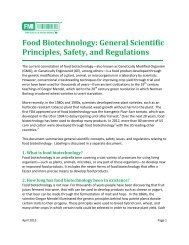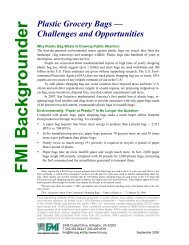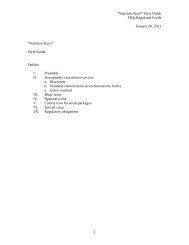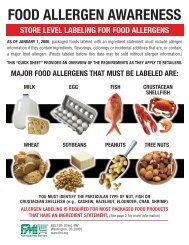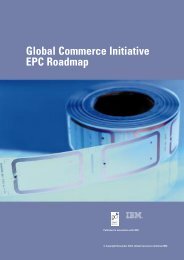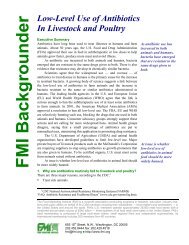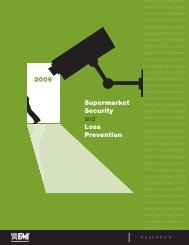Shelf Price Accuracy in Supermarkets That Scan - Food Marketing ...
Shelf Price Accuracy in Supermarkets That Scan - Food Marketing ...
Shelf Price Accuracy in Supermarkets That Scan - Food Marketing ...
Create successful ePaper yourself
Turn your PDF publications into a flip-book with our unique Google optimized e-Paper software.
<strong>Shelf</strong> <strong>Price</strong> <strong>Accuracy</strong> <strong>in</strong><br />
<strong>Supermarkets</strong> <strong>That</strong> <strong>Scan</strong><br />
Introduction and Executive Summary<br />
<strong>Scan</strong>ners were <strong>in</strong>troduced <strong>in</strong> supermarkets <strong>in</strong> 1974 to improve efficiency<br />
and productivity <strong>in</strong> the food distribution system. The technology has<br />
brought many benefits to both consumers and the supermarket <strong>in</strong>dustry.<br />
For example, scanners:<br />
• Reduce checkout time.<br />
• Provide consumers a receipt that details the type and price of each<br />
item purchased.<br />
• Help control costs by elim<strong>in</strong>at<strong>in</strong>g the labor needed to <strong>in</strong>dividually<br />
mark items.<br />
• Generate electronic coupons for the products that customers purchase.<br />
• Provide a means to help prevent the sale of alcohol and tobacco<br />
products to m<strong>in</strong>ors. Some supermarkets have programmed the registers<br />
to stop whenever such items are scanned, prompt<strong>in</strong>g the cashier<br />
to check customer ID cards.<br />
• Provide a way to enhance and monitor price accuracy at the shelf.<br />
Concerns have been raised about discrepancies between the prices on<br />
the shelf and <strong>in</strong> the scanner at the checkout counter. This issue has often<br />
been described as one of “scanner error”; that term is mislead<strong>in</strong>g, however,<br />
because it fails to identify the true cause, which is human error. When discrepancies<br />
occur, the technology itself is not malfunction<strong>in</strong>g; rather, store<br />
employees are not chang<strong>in</strong>g the shelf and scanner price at the same time.<br />
S<strong>in</strong>ce price changes are typically made <strong>in</strong> the scanner, the scanner reflects<br />
the true price. For this reason, the issue is better described as one of “shelf<br />
price accuracy.”<br />
<strong>Supermarkets</strong> have always faced the challenge of controll<strong>in</strong>g pricemark<strong>in</strong>g<br />
consistency ⎯ a challenge that has <strong>in</strong>creased as typical store <strong>in</strong>ventories<br />
have grown to a range of 30,000 to 50,000 separate items. In addition,<br />
competition has prompted stores to make more price changes ⎯<br />
typically, hundreds per week ⎯ <strong>in</strong>creas<strong>in</strong>g the opportunities for human error.<br />
<strong>Supermarkets</strong> have the<br />
highest price accuracy<br />
rate among all types of<br />
retailers.<br />
<strong>Food</strong> Market<strong>in</strong>g Institute (FMI) conducts programs <strong>in</strong> research, education, <strong>in</strong>dustry relations and public affairs on behalf<br />
of its 2,300 member companies — food retailers and wholesalers — <strong>in</strong> the United States and around the world.<br />
FMI’s U.S. members operate approximately 26,000 retail food stores with a comb<strong>in</strong>ed annual sales volume of $340<br />
billion — three-quarters of all food retail store sales <strong>in</strong> the United States. FMI’s retail membership is composed of<br />
large multi-store cha<strong>in</strong>s, regional firms and <strong>in</strong>dependent supermarkets. Its <strong>in</strong>ternational membership <strong>in</strong>cludes 200<br />
companies from 60 countries.<br />
November 2001<br />
655 15 th Street, N.W., Wash<strong>in</strong>gton, DC 20005<br />
202.452.8444 • fax: 202.429.4519<br />
fmi@fmi.org • http://www.fmi.org
<strong>Shelf</strong> <strong>Price</strong> <strong>Accuracy</strong> <strong>in</strong> <strong>Supermarkets</strong> <strong>That</strong> <strong>Scan</strong><br />
In stores that lack scanners, discrepancies occur when checkers <strong>in</strong>advertently<br />
r<strong>in</strong>g up the wrong prices or when employees fail to make price<br />
changes <strong>in</strong> a uniform manner. Discrepancy rates are higher <strong>in</strong> stores that<br />
mark items <strong>in</strong>dividually because this practice <strong>in</strong>creases the opportunities<br />
for human error.<br />
The <strong>in</strong>dustry is improv<strong>in</strong>g accuracy with technologies that change<br />
prices on shelf tags and scanners at the same time. In another solution, employees<br />
use portable computers to pr<strong>in</strong>t out new shelf labels <strong>in</strong> the aisles.<br />
Many supermarkets are upgrad<strong>in</strong>g management controls, such as conduct<strong>in</strong>g<br />
frequent shelf price accuracy audits and assign<strong>in</strong>g employees to monitor<br />
price changes full-time.<br />
Us<strong>in</strong>g the measures described above, supermarkets have reduced error<br />
rates, accord<strong>in</strong>g to research by the Federal Trade Commission (FTC).<br />
In the days before scann<strong>in</strong>g, error rates were as high as 16 percent. With<br />
the help of scann<strong>in</strong>g and tighter controls, supermarkets reduced the rate to<br />
2.42 percent <strong>in</strong> 1998, the most recent year for which FTC data is available<br />
(<strong>Price</strong> Check II ⎯ A Follow-up Report on the <strong>Accuracy</strong> of Checkout<br />
<strong>Scan</strong>ners). <strong>That</strong> rate <strong>in</strong>cludes both overcharges and undercharges, which<br />
were nearly the same at 1.36 percent and 1.06 percent, respectively.<br />
<strong>Supermarkets</strong> also have the highest price accuracy rate among all<br />
types of retailers. The error rate for other retailers covered <strong>in</strong> the FTC report<br />
was 3.99 percent.<br />
In addition, weights and measures officials have stepped up enforcement<br />
of laws that penalize retailers for overcharges. Also, their govern<strong>in</strong>g<br />
body, the National Conference on Weights and Measures (NCWM), developed<br />
a methodology to measure price consistency more accurately and<br />
better gauge the success of efforts to improve it. The methodology is described<br />
<strong>in</strong> the guide titled Exam<strong>in</strong>ation Procedure for <strong>Price</strong> Verification.<br />
1. What are scanner pric<strong>in</strong>g errors and how do they occur<br />
The most common ones are discrepancies between the prices charged<br />
at the register and those posted on the shelf, result<strong>in</strong>g <strong>in</strong> either an undercharge<br />
or overcharge for the customer. Such <strong>in</strong>consistencies are a product<br />
of human error: <strong>in</strong> most cases, store employees enter a price change <strong>in</strong> the<br />
scann<strong>in</strong>g system without updat<strong>in</strong>g the shelf tag.<br />
2. Is the supermarket <strong>in</strong>dustry concerned about this issue<br />
Absolutely. Overcharges erode customer loyalty, and undercharges<br />
cost the <strong>in</strong>dustry. <strong>Supermarkets</strong> are striv<strong>in</strong>g to achieve 100 percent pric<strong>in</strong>g<br />
accuracy. Many have virtually elim<strong>in</strong>ated overcharges with a relatively<br />
simple price-change practice: When the price of an item <strong>in</strong>creases, they<br />
change the shelf label first and then the scanned price at the checkout;<br />
when the price decreases, they change it <strong>in</strong> the scanner first. This practice<br />
helps ensure that any errors will favor the customer.<br />
3. How much do pric<strong>in</strong>g errors cost customers<br />
The most reliable data show that the cost to consumers is m<strong>in</strong>imal.<br />
The 1998 FTC report found that the error rate among food retailers averaged<br />
2.42 percent with overcharges and undercharges about equal, 1.35<br />
The <strong>in</strong>dustry is<br />
improv<strong>in</strong>g accuracy with<br />
technologies that<br />
change prices on shelf<br />
tags and scanners at the<br />
same time.<br />
The most reliable<br />
data show that the<br />
cost to consumers is<br />
m<strong>in</strong>imal.<br />
<strong>Food</strong> Market<strong>in</strong>g Institute 2
<strong>Shelf</strong> <strong>Price</strong> <strong>Accuracy</strong> <strong>in</strong> <strong>Supermarkets</strong> <strong>That</strong> <strong>Scan</strong><br />
percent vs. 1.06 percent (<strong>Price</strong> Check II — A Follow-up Report on the <strong>Accuracy</strong><br />
of Checkout <strong>Scan</strong>ners). The average overcharge was 66 cents. This<br />
report was based on a review of 32,753 items checked <strong>in</strong> 555 food retail<br />
stores <strong>in</strong> 36 states and the Virg<strong>in</strong> Islands.<br />
A three-year study by The Center for Retail<strong>in</strong>g at the University of<br />
South Carol<strong>in</strong>a found that the error rate averaged 2.74 percent with undercharges<br />
exceed<strong>in</strong>g overcharges 1.47 percent to 1.27 percent. Grocery<br />
stores had a much lower error rate than other retail outlets, <strong>in</strong> which the<br />
rate averaged 6.01 percent. These f<strong>in</strong>d<strong>in</strong>gs were based on a sample of<br />
96,080 items checked <strong>in</strong> 1,582 stores <strong>in</strong> n<strong>in</strong>e states from 1994 to 1997<br />
(Guy Richard Clodfelter, “Pric<strong>in</strong>g <strong>Accuracy</strong> at Grocery Stores and Other<br />
Retail Stores Us<strong>in</strong>g <strong>Scan</strong>n<strong>in</strong>g,” International Journal of Retail & Distribution<br />
Management, Volume 26, Number 11, 1998).<br />
The FTC and South Carol<strong>in</strong>a data are based on a methodology developed<br />
by the National Conference on Weights and Measures (NCWM),<br />
titled the Exam<strong>in</strong>ation Procedure for <strong>Price</strong> Verification. More than 40<br />
states are now us<strong>in</strong>g the methodology to generate scientifically valid data.<br />
Among its requirements are that the m<strong>in</strong>imum sample size per store be 50<br />
items and that the sampl<strong>in</strong>g be conducted on a random basis, cover<strong>in</strong>g<br />
products both on sale and not. Studies that do not meet such m<strong>in</strong>imum requirements<br />
are most likely <strong>in</strong>valid.<br />
4. What about claims that scann<strong>in</strong>g errors cost consumers<br />
$1 billion or more a year<br />
There is no factual basis for such claims. In a November 1992 article<br />
(“The <strong>Price</strong> is Wrong”), Information Week magaz<strong>in</strong>e estimated that scanner<br />
errors cost consumers $2.5 billion year. The estimate was based on<br />
false assumptions. Cit<strong>in</strong>g a 1990 study, the magaz<strong>in</strong>e reported that supermarket<br />
shelf prices “fail to match scanner prices 5 percent of the time.”<br />
More recent and comprehensive research by the University of South Carol<strong>in</strong>a<br />
puts the rate at 2.74 percent, with more than half the errors (1.47 percent)<br />
represent<strong>in</strong>g undercharges.<br />
Then the magaz<strong>in</strong>e arbitrarily equated the error rate with the error<br />
cost to estimate $7 billion <strong>in</strong> pric<strong>in</strong>g mistakes on $140 billion <strong>in</strong> sales <strong>in</strong><br />
supermarkets that scan. The states that gather such data, however, f<strong>in</strong>d that<br />
cost of pric<strong>in</strong>g errors is an extremely small percentage of sales. The magaz<strong>in</strong>e<br />
also assumed that overcharges exceed undercharges by a two-to-one<br />
ratio despite the fact that the most current and scientifically valid data<br />
shows that the ratio is about one-to-one.<br />
Money magaz<strong>in</strong>e alleged that price errors cost consumers $1 billion a<br />
year <strong>in</strong> its April 1993 issue (“Don’t Get Cheated by Supermarket <strong>Scan</strong>ners”).<br />
This claim has no statistical validity s<strong>in</strong>ce it was based on samples<br />
of only 10 items per store. Samples of at least 50 randomly selected items<br />
are required <strong>in</strong> the NCWM’s model methodology.<br />
A three-year study by<br />
The Center for Retail<strong>in</strong>g<br />
at the University of South<br />
Carol<strong>in</strong>a found that the<br />
error rate averaged<br />
2.74 percent, with<br />
undercharges exceed<strong>in</strong>g<br />
overcharges 1.47 percent<br />
to 1.27 percent.<br />
More than 40 states are<br />
now us<strong>in</strong>g the [NCWM]<br />
methodology to generate<br />
scientifically valid data.<br />
Among its requirements<br />
are that the m<strong>in</strong>imum<br />
sample size per store be 50<br />
items and that the<br />
sampl<strong>in</strong>g be conducted on<br />
a random basis . . . .<br />
Studies that do not meet<br />
such m<strong>in</strong>imum<br />
requirements are most<br />
likely <strong>in</strong>valid.<br />
<strong>Food</strong> Market<strong>in</strong>g Institute 3
<strong>Shelf</strong> <strong>Price</strong> <strong>Accuracy</strong> <strong>in</strong> <strong>Supermarkets</strong> <strong>That</strong> <strong>Scan</strong><br />
5. What steps are supermarkets tak<strong>in</strong>g to improve pric<strong>in</strong>g<br />
accuracy<br />
Many supermarkets assign the responsibility for ma<strong>in</strong>ta<strong>in</strong><strong>in</strong>g consistent<br />
shelf and scanner prices to one <strong>in</strong>dividual, often called a price coord<strong>in</strong>ator.<br />
The coord<strong>in</strong>ator's duties <strong>in</strong>clude implement<strong>in</strong>g all price changes;<br />
updat<strong>in</strong>g and ma<strong>in</strong>ta<strong>in</strong><strong>in</strong>g the scann<strong>in</strong>g system at the front end; and verify<strong>in</strong>g<br />
and ma<strong>in</strong>ta<strong>in</strong><strong>in</strong>g shelf labels, ad signs and pric<strong>in</strong>g reports.<br />
• <strong>Supermarkets</strong> conduct regular store audits and surveys to make sure<br />
the prices on the shelf, <strong>in</strong> the scanner and elsewhere all match.<br />
• Some companies have formed <strong>in</strong>ternal task forces to improve pric<strong>in</strong>g<br />
accuracy.<br />
• <strong>Supermarkets</strong> teach their employees to report and correct errors <strong>in</strong> a<br />
timely manner and reward customers who are overcharged for items.<br />
• <strong>Supermarkets</strong> are <strong>in</strong>stall<strong>in</strong>g electronic shelf labels (ESL), which enable<br />
retailers to change an item’s shelf and checkout price simultaneously.<br />
This technology is now used by 15 percent of food retailers,<br />
accord<strong>in</strong>g to the report FMI Technology Review Highlights, 2000.<br />
• Stores that use wireless/RF communication can quickly provide<br />
po<strong>in</strong>t-of-sale (POS) price verification. Remote checkout stands can<br />
communicate with the store’s database without be<strong>in</strong>g physically attached<br />
to a local area network. Clerks, us<strong>in</strong>g wireless communication<br />
(hand-held scanners), can verify shelf prices from anywhere <strong>in</strong> the<br />
store.<br />
The <strong>Food</strong> Market<strong>in</strong>g Institute (FMI) developed a best practices guide<br />
that describes the measures above and others: <strong>Price</strong> Verification ⎯ Ensur<strong>in</strong>g<br />
<strong>Accuracy</strong> at Store Level.<br />
6. How does the government monitor price accuracy<br />
Local and state weights and measures officials rout<strong>in</strong>ely check shelf<br />
and scan price accuracy <strong>in</strong> supermarkets and other retail establishments.<br />
Many jurisdictions impose large civil, crim<strong>in</strong>al and adm<strong>in</strong>istrative penalties<br />
— <strong>in</strong>clud<strong>in</strong>g f<strong>in</strong>es as high as $1 million — and support class action<br />
suits aga<strong>in</strong>st retailers. Officials often make public the results of accuracy<br />
surveys to help consumers evaluate the performance of various stores. In<br />
recent years, government officials have begun address<strong>in</strong>g the problem<br />
more aggressively with larger f<strong>in</strong>es and more frequent price checks.<br />
Many supermarkets<br />
assign the responsibility<br />
for ma<strong>in</strong>ta<strong>in</strong><strong>in</strong>g<br />
consistent shelf and<br />
scanner prices to one<br />
<strong>in</strong>dividual, often called a<br />
price coord<strong>in</strong>ator.<br />
Local and state weights<br />
and measures officials<br />
rout<strong>in</strong>ely check shelf<br />
and scan price accuracy<br />
<strong>in</strong> supermarkets and<br />
other retail<br />
establishments.<br />
7. What should consumers do if they f<strong>in</strong>d a difference<br />
between the shelf price and the scanned price<br />
Immediately report the discrepancy to the cashier and <strong>in</strong>quire about<br />
the store’s policy for address<strong>in</strong>g price errors. These policies may <strong>in</strong>clude:<br />
• Giv<strong>in</strong>g the customer the item for free.<br />
• Provid<strong>in</strong>g a coupon for a free item.<br />
• Award<strong>in</strong>g the customer a fixed dollar amount.<br />
• Award<strong>in</strong>g the customer the difference <strong>in</strong> price.<br />
<strong>Food</strong> Market<strong>in</strong>g Institute 4
<strong>Shelf</strong> <strong>Price</strong> <strong>Accuracy</strong> <strong>in</strong> <strong>Supermarkets</strong> <strong>That</strong> <strong>Scan</strong><br />
8. Would elim<strong>in</strong>at<strong>in</strong>g scanners improve the accuracy rate<br />
No. <strong>Supermarkets</strong> carry from 30,000 to 50,000 different items and<br />
make hundreds of price changes every week. Requir<strong>in</strong>g all prices to be<br />
changed manually on all items would <strong>in</strong>crease the discrepancy rate because<br />
it <strong>in</strong>troduces many more opportunities for human error. Studies have<br />
shown that manual entry of prices result <strong>in</strong> error rates of 4.4–16 percent,<br />
accord<strong>in</strong>g to the FTC.<br />
Customers would also lose the many benefits of scanners. The technology<br />
reduces checkout time and provides receipts that detail each item<br />
purchased. It also helps supermarkets control costs by elim<strong>in</strong>at<strong>in</strong>g the labor<br />
needed to mark items <strong>in</strong>dividually. Many supermarkets program their<br />
scanners to generate electronic coupons for items that consumers purchase.<br />
<strong>Supermarkets</strong> also use the data gathered by scanners to tailor product assortment<br />
more precisely to consumer demand.<br />
9. How does item pric<strong>in</strong>g legislation enter <strong>in</strong>to this issue<br />
Some consumer advocates and lawmakers believe that requir<strong>in</strong>g<br />
stores to <strong>in</strong>dividually price each item will improve accuracy and give<br />
shoppers a convenient means to verify price consistency at the checkout.<br />
Five states and many local jurisdictions currently have item pric<strong>in</strong>g laws.<br />
Some laws feature a trigger mechanism, requir<strong>in</strong>g retailers to item-price<br />
when accuracy rates fall below a certa<strong>in</strong> level, such as 98 percent <strong>in</strong> a 300-<br />
item sample.<br />
10. Is item pric<strong>in</strong>g necessary to improve accuracy rates<br />
No — just the contrary. Individual item price-mark<strong>in</strong>g provides more<br />
opportunities for human error. Instead of mak<strong>in</strong>g a s<strong>in</strong>gle price change on<br />
the shelf tag, item pric<strong>in</strong>g requires employees to re-price the entire stock of<br />
each item — often <strong>in</strong>volv<strong>in</strong>g hundreds of price changes. Comparative data<br />
show that stores that item-price have higher error rates. <strong>Price</strong> error rates<br />
range from 4 percent to 7 percent <strong>in</strong> stores that item-price, accord<strong>in</strong>g to the<br />
NCWM, compared with rates that are half as much <strong>in</strong> stores that only scan.<br />
In addition, item pric<strong>in</strong>g could lead to cost <strong>in</strong>creases to cover the extra<br />
labor required to label each <strong>in</strong>dividual product. Labor is the largest s<strong>in</strong>gle<br />
cost for supermarkets, account<strong>in</strong>g for 36 cents out of each dollar that<br />
consumers spend on food. <strong>Supermarkets</strong> can achieve 100 percent accuracy<br />
rates with improved management practices, technology and other measures<br />
⎯ without item pric<strong>in</strong>g.<br />
Requir<strong>in</strong>g all prices to<br />
be changed manually on<br />
all items would <strong>in</strong>crease<br />
the discrepancy rate<br />
because it <strong>in</strong>troduces<br />
many more opportunities<br />
for human error.<br />
Item pric<strong>in</strong>g could<br />
lead to cost <strong>in</strong>creases<br />
to cover the extra<br />
labor required to label<br />
each <strong>in</strong>dividual<br />
product.<br />
<strong>Food</strong> Market<strong>in</strong>g Institute 5
<strong>Shelf</strong> <strong>Price</strong> <strong>Accuracy</strong> <strong>in</strong> <strong>Supermarkets</strong> <strong>That</strong> <strong>Scan</strong><br />
Sources of Additional Information<br />
Ken Butcher, G. Thomas Coleman<br />
Coord<strong>in</strong>ators, U.S. Department of Commerce<br />
National Institute of Standards and Technology<br />
Build<strong>in</strong>g 820, Room 223<br />
Gaithersburg, MD 20899<br />
301-975-3991<br />
G. Richard Clodfelter, Associate Professor<br />
Center for Retail<strong>in</strong>g<br />
College of Applied Professional Sciences<br />
University of South Carol<strong>in</strong>a<br />
Columbia, SC 29208<br />
803-777-7622<br />
Gene A. German,<br />
Professor of Market<strong>in</strong>g, Cornell University<br />
206 Warren Hall<br />
Ithaca, NY 14853<br />
607-255-2183<br />
State Departments of Weights and Measures<br />
FMI publication: <strong>Price</strong> Verification —<br />
Ensur<strong>in</strong>g <strong>Accuracy</strong> at Store Level<br />
Publications and Video Sales Department<br />
<strong>Food</strong> Market<strong>in</strong>g Institute<br />
655 15th Street, N.W., Suite 700<br />
Wash<strong>in</strong>gton, DC 20005<br />
202-220-0723<br />
<strong>Food</strong> Market<strong>in</strong>g Institute 6


